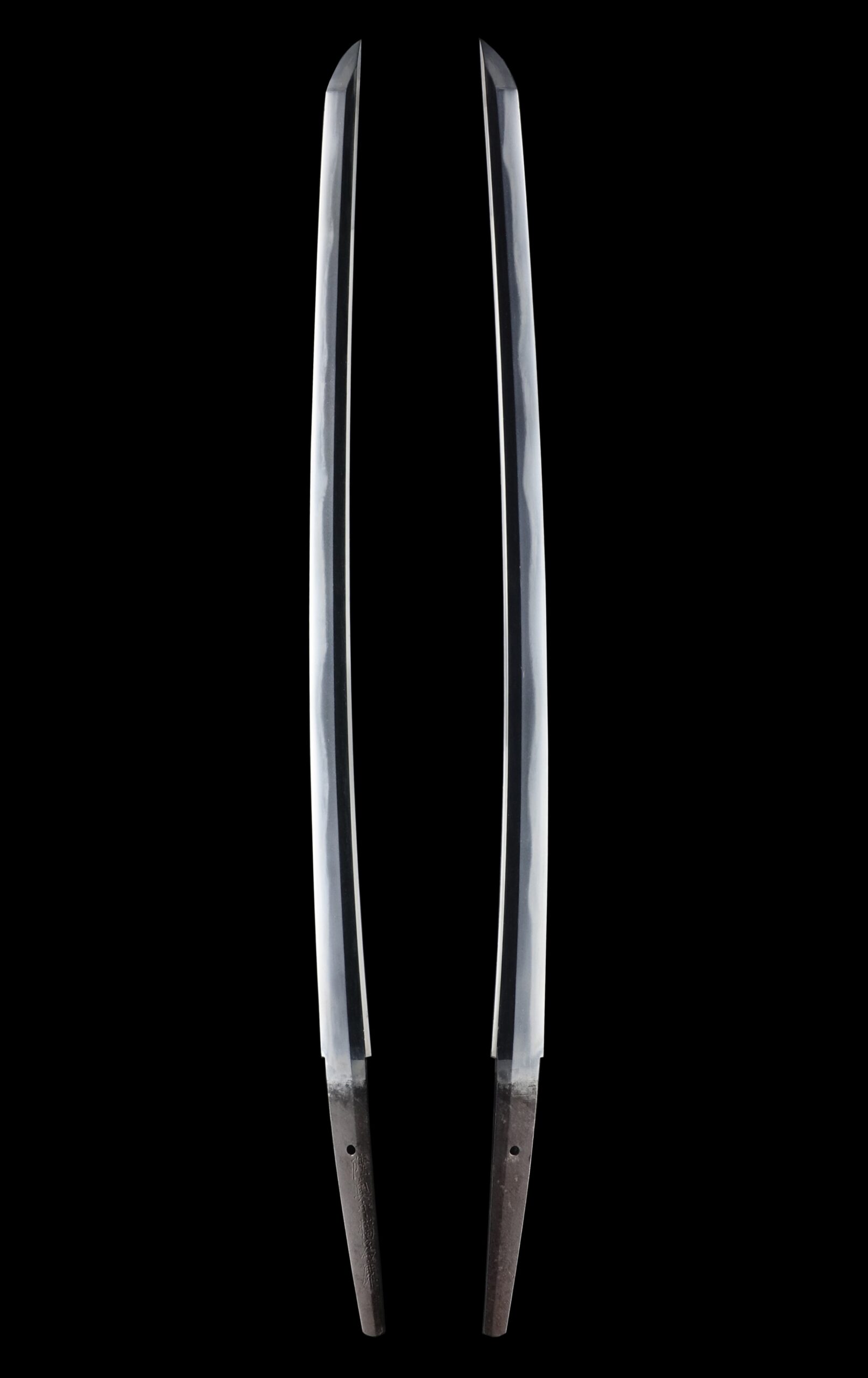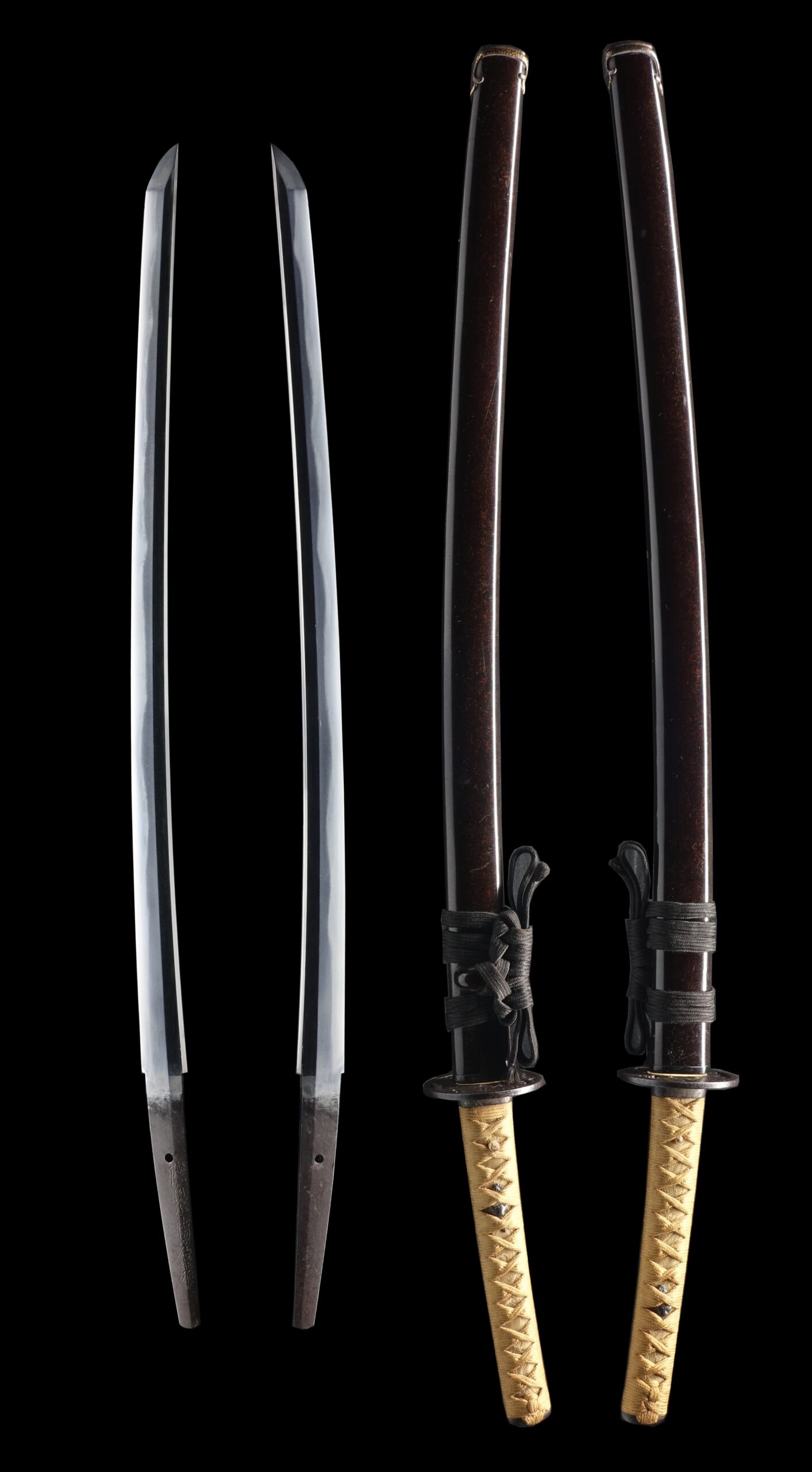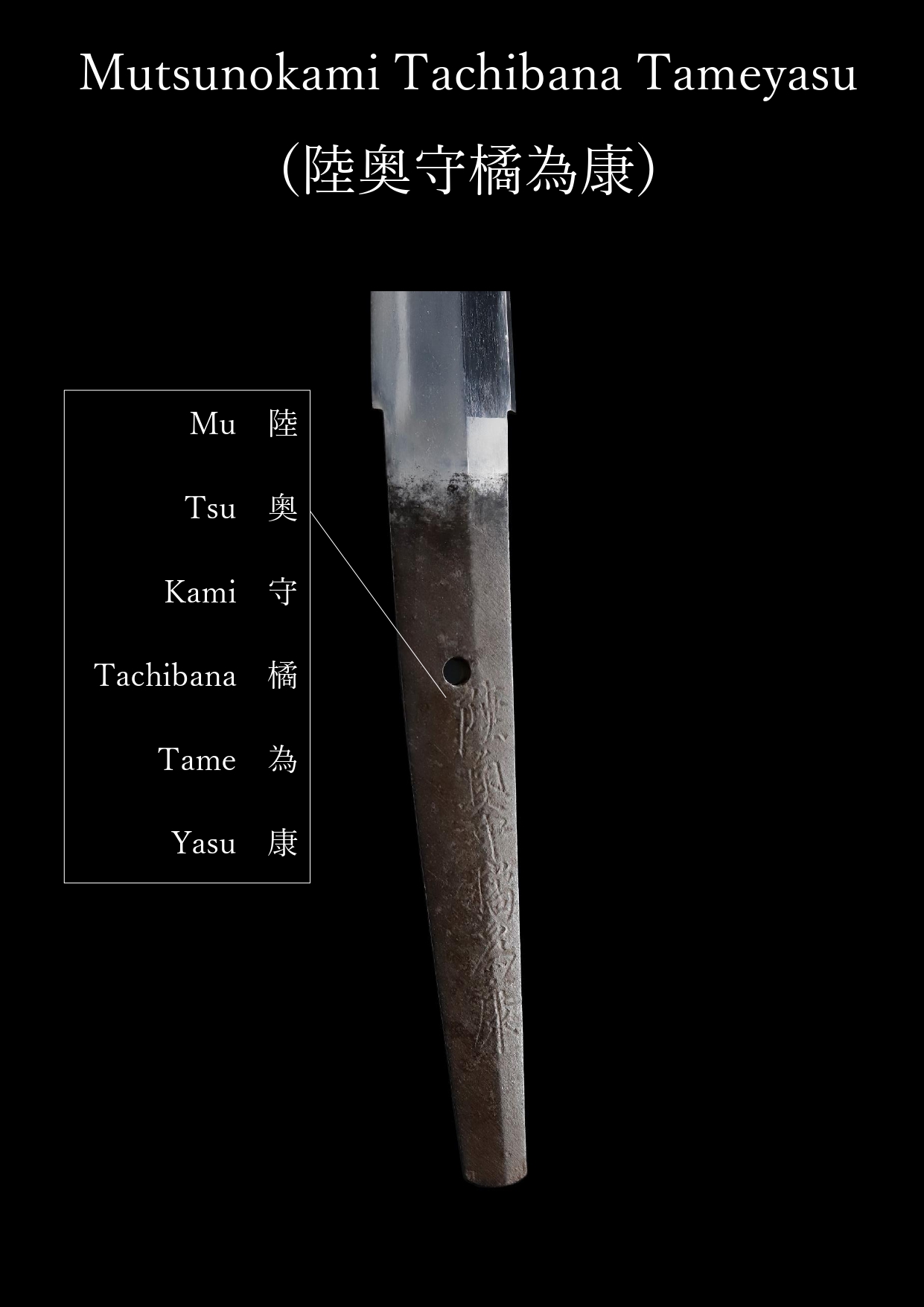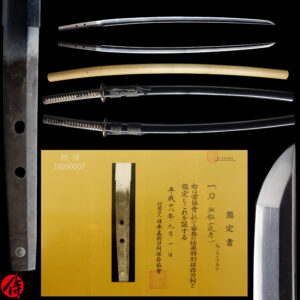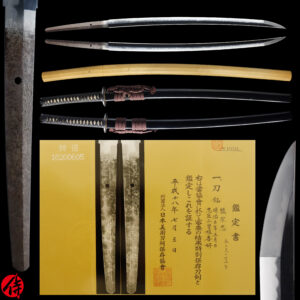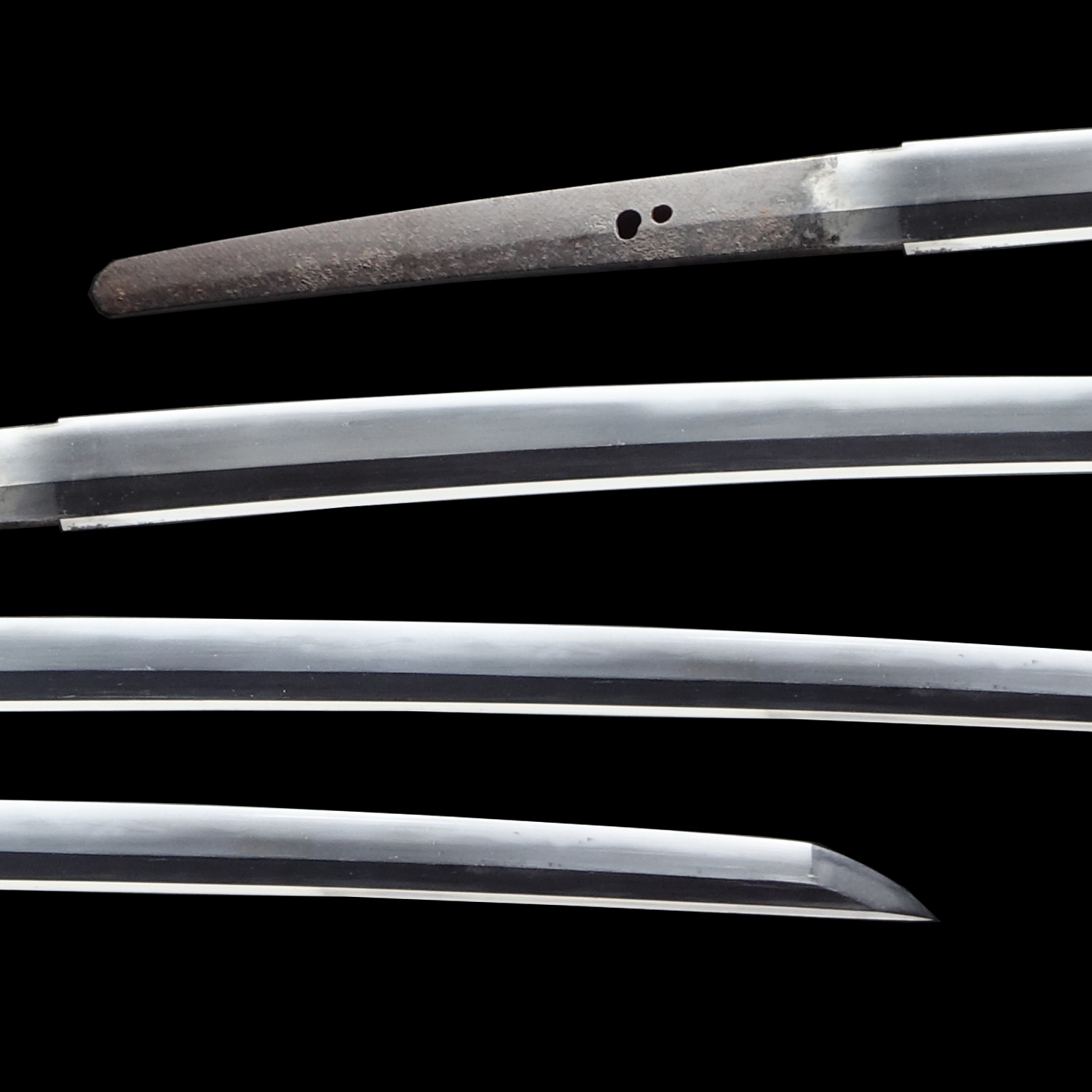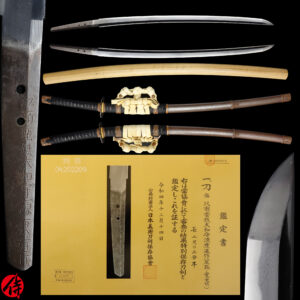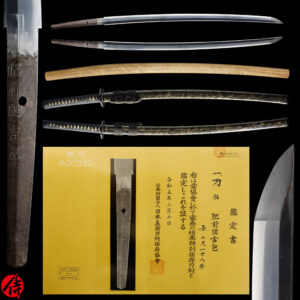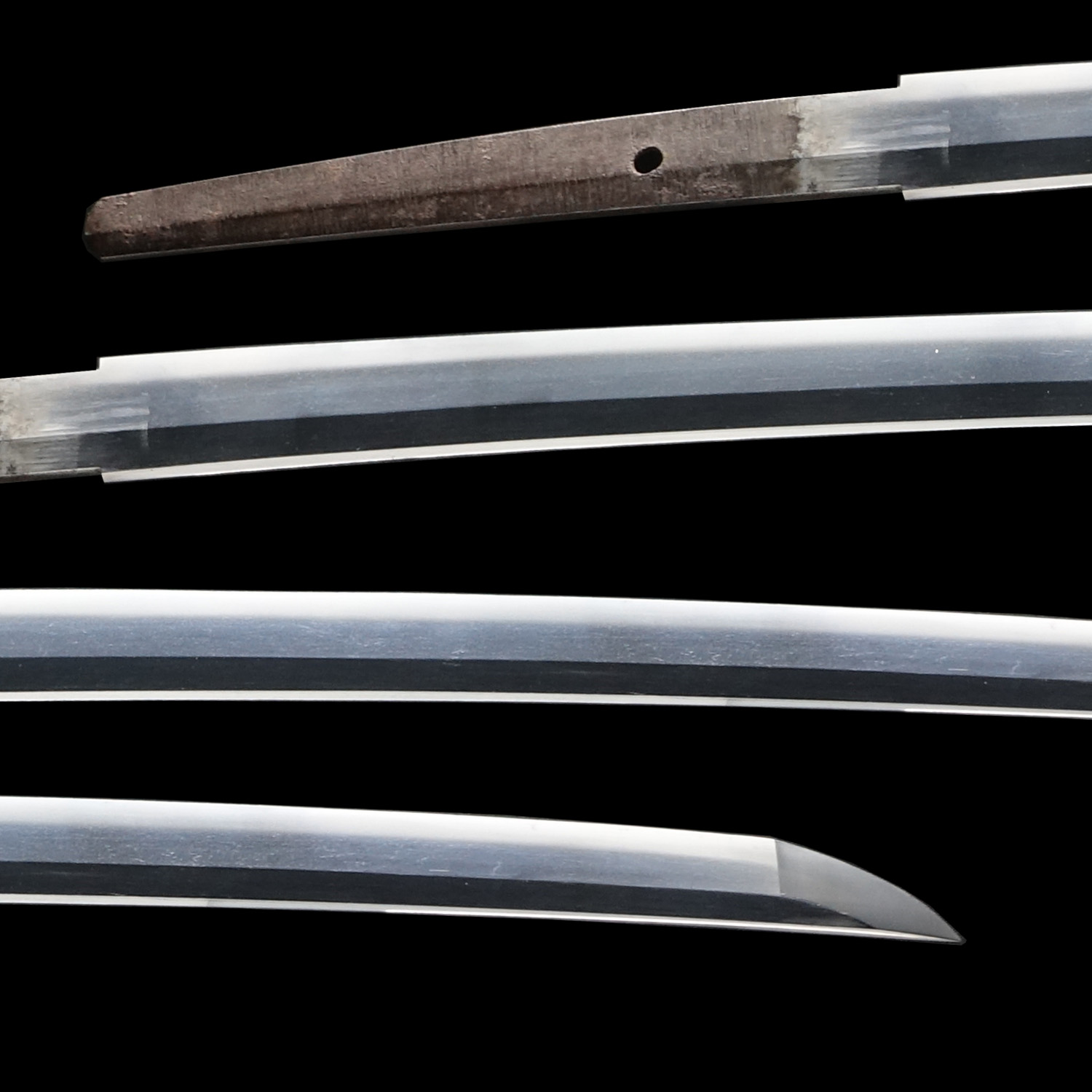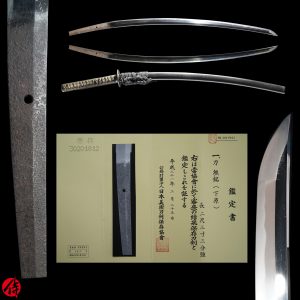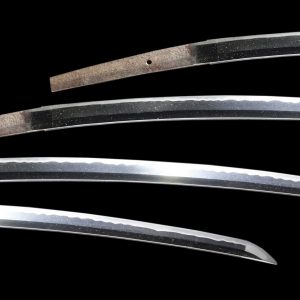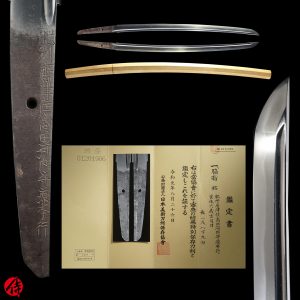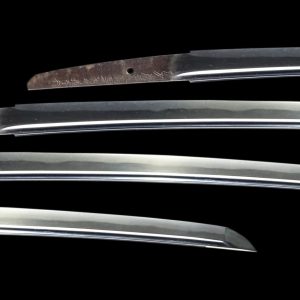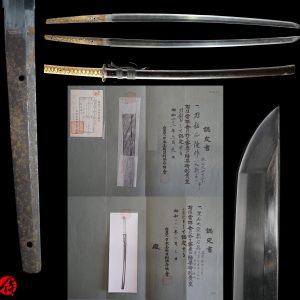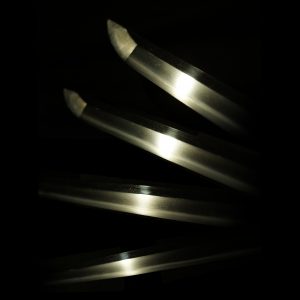Antique Japanese Sword Katana Signed by Tameyasu with Tokubetsu Hozon Certificate
【Description】
This blade was forged by Mutsu no kami Tachibana Tameyasu(陸奥守橘為康) during the Kanbun-Enpo era(1661-1681:Early Edo period). Tameyasu was the maker’s name used by the second-gen Kishu Ishido Yasuhiro at the end of his career.
His father was Tosa Shogen Tachibana Yasuhiro(土佐将監橘康廣), and his younger brother is Bitchu no kami Yasuhiro, both of whom are famous swordsmiths.His real name is Tomita Goro Zaemon(富田五郎左衛門). Tameyasu belonged to a prestigious sword school called Kishu Ishido and Osaka Ishido School.
His father was born in Omi province, located in Shiga prefecture. And he belonged to Omi Ishido school during the early Edo period.
Ishido school was initially founded by Sukenaga, an offspring of Ichimonji Sukemune, who made Fukuoka Ichimonji school in Bizen province(Today’s Okayama prefecture).
During 1492-1501(Mid Muromachi period), Sukenaga and his school moved to Omi province from Bizen province after being summoned by Gamou family, a powerful feudal line in that region. Sukenaga started to live in front of Ishido temple, and he changed his surname to Ishido.
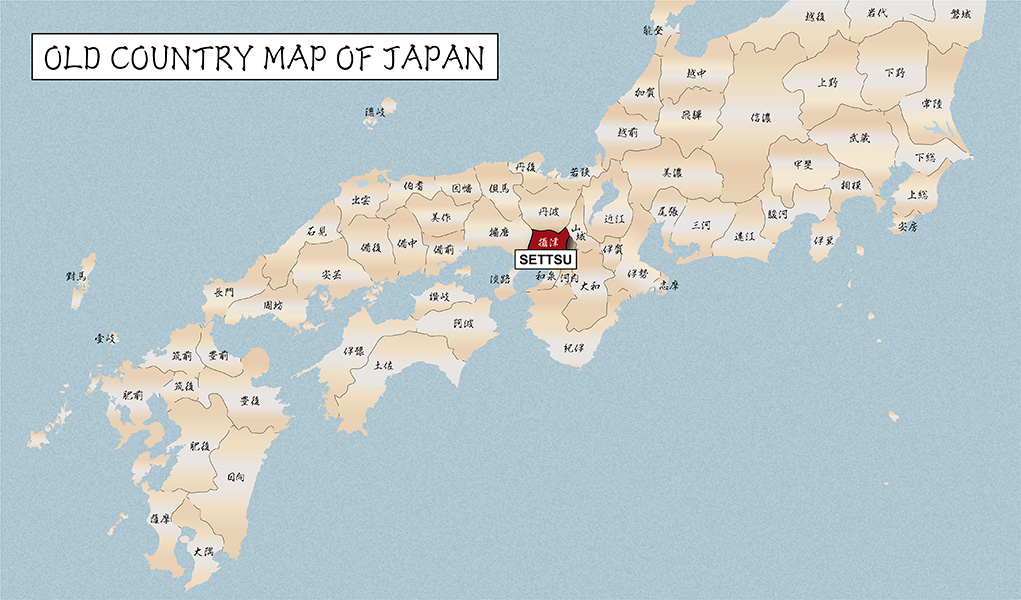
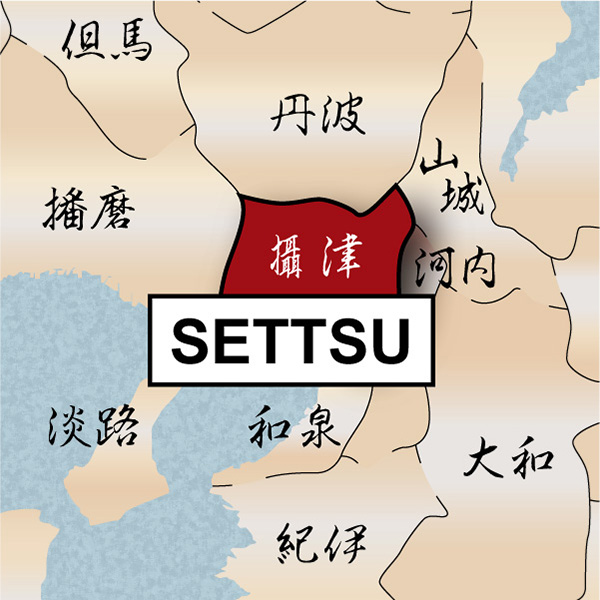
As of the early Edo period, many Ishido swordsmiths moved to other parts of Japan. There are four areas: Edo, Osaka, Kishu(Wakayama prefecture), and Chikuzen(Fukuoka prefecture). Omi Ishido school is the origin of whole other Ishido branches that flourished during the Edo period. Following this trend, his father moved to Kishu province from Omi province. It is said that the father was the founder of Kishu Ishido school. Tameyasu and his father forged swords near Wakayama castle in Kishu province first.
And, they moved to Settsu city in Osaka. They also built the foundation of Osaka Sekido school.Tameyasu is known as one of the most prominent figures that made Osaka Isido school prosperous during the early Edo period.
It is appraised as a Tokubetsu Hozon Token(特別保存刀剣) issued by NBTHK(Nihon Bijutsu Touken Hozon Kyokai:日本美術刀剣保存協会). This authentication paper was only given to authentic Japanese swords, especially well preserved and high quality with artistic value.
【 Blade】
Cutting Edge Length(Nagasa): 62.2 cm ( 24.5 inches)
Curvature(Sori): 1.0 cm ( 0.39 inches)

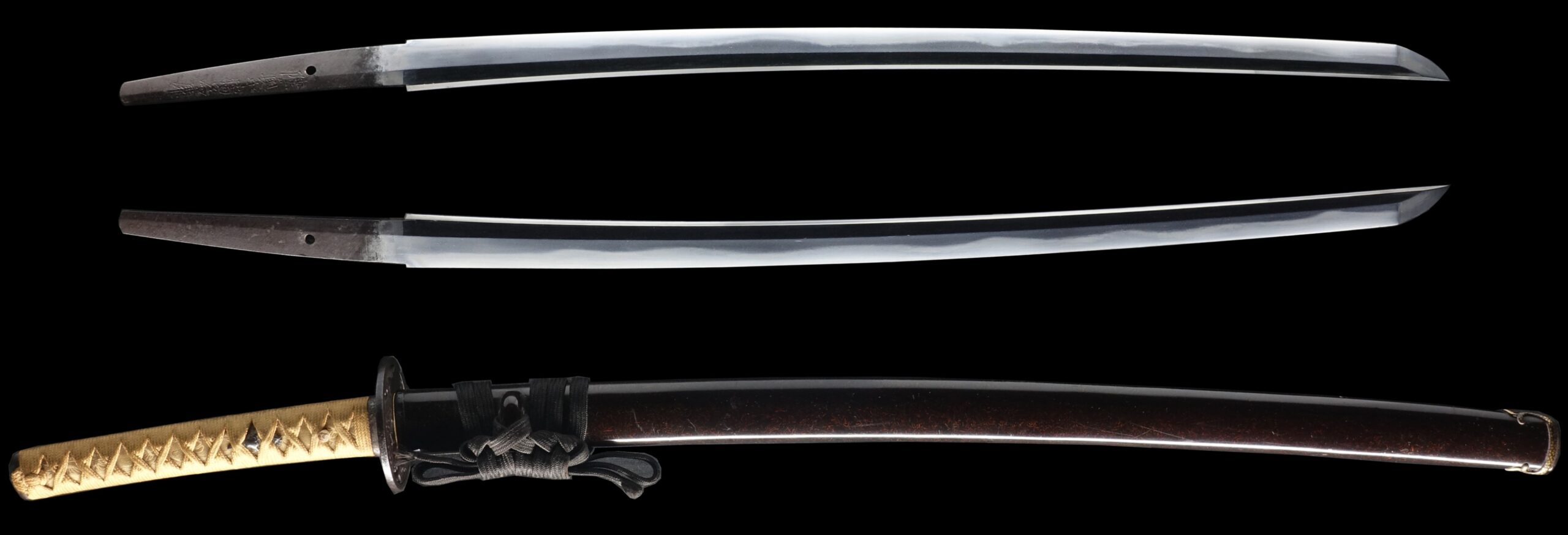
Hamon:
The crystalline structure which forms along the cutting edge of a blade as a result of the hardening process
Jimon(Jihada):
visible steel surface pattern created by folding and hammering during forging process

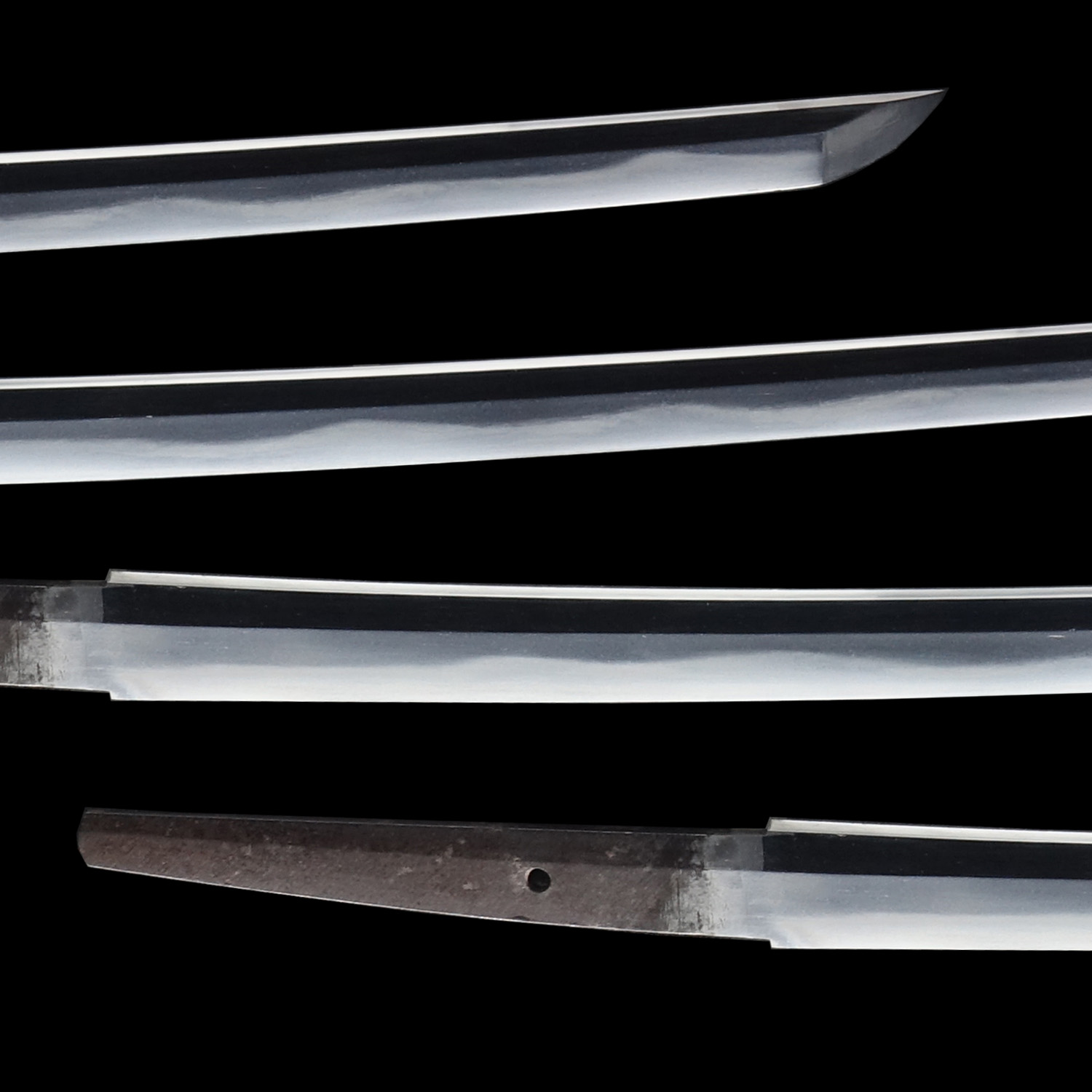
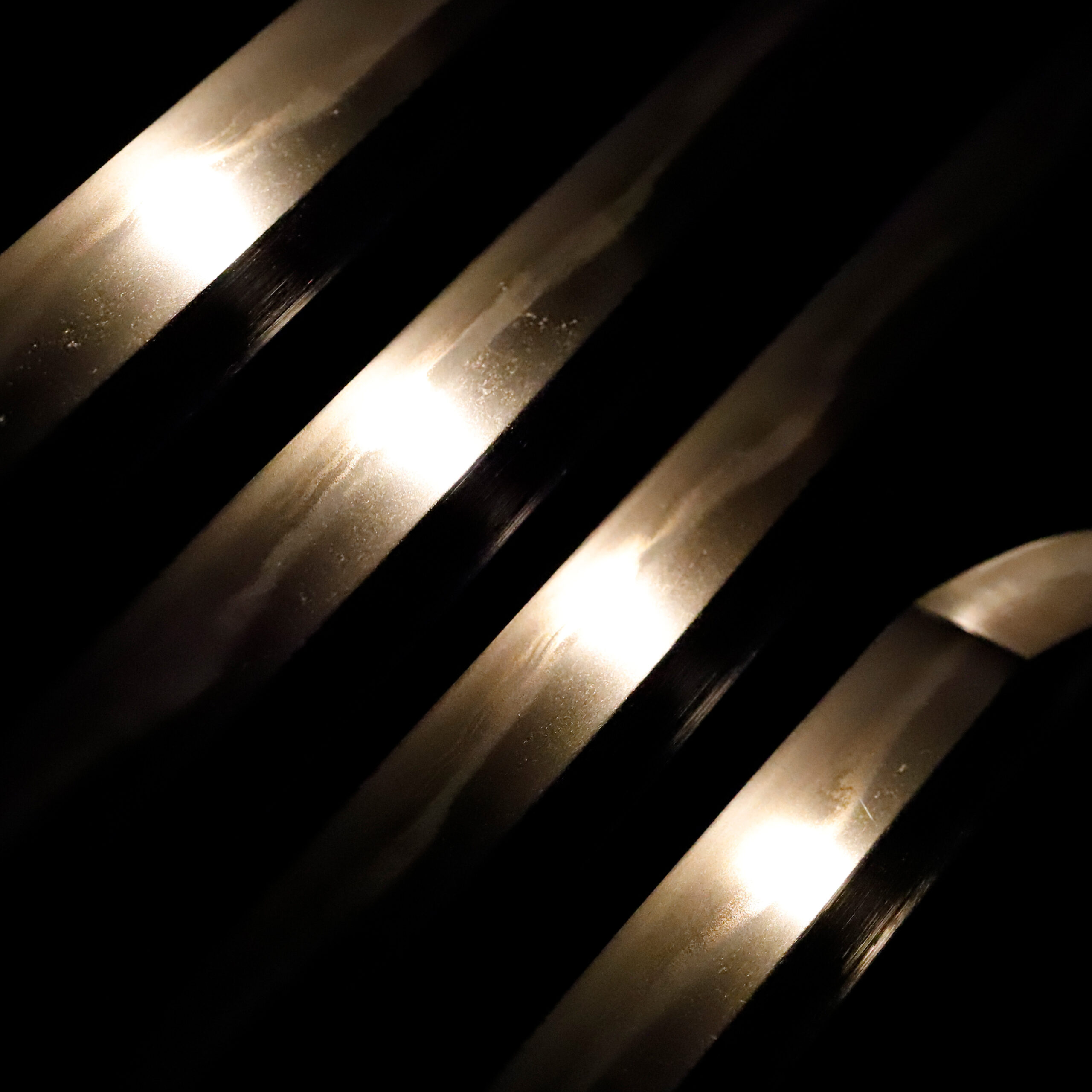

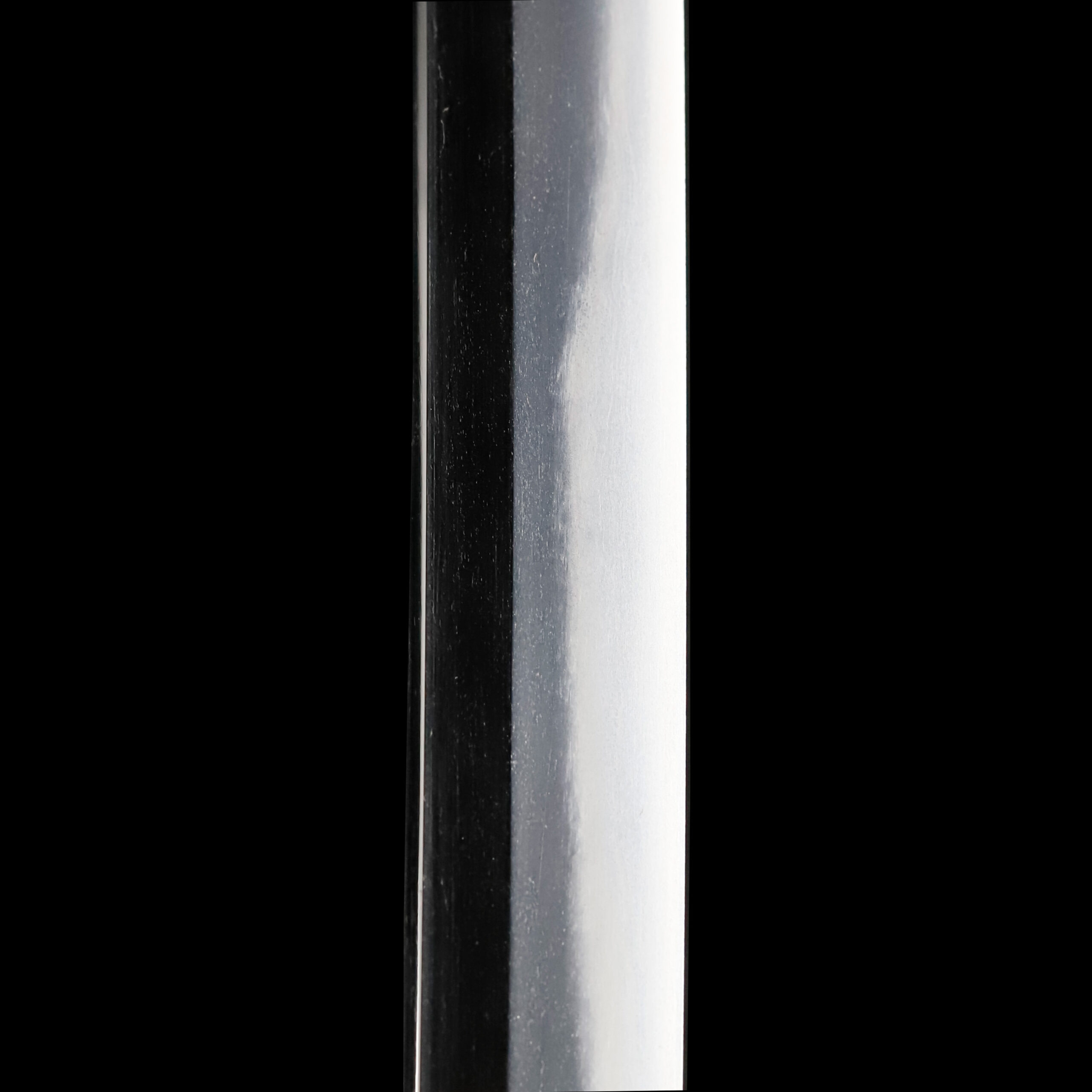
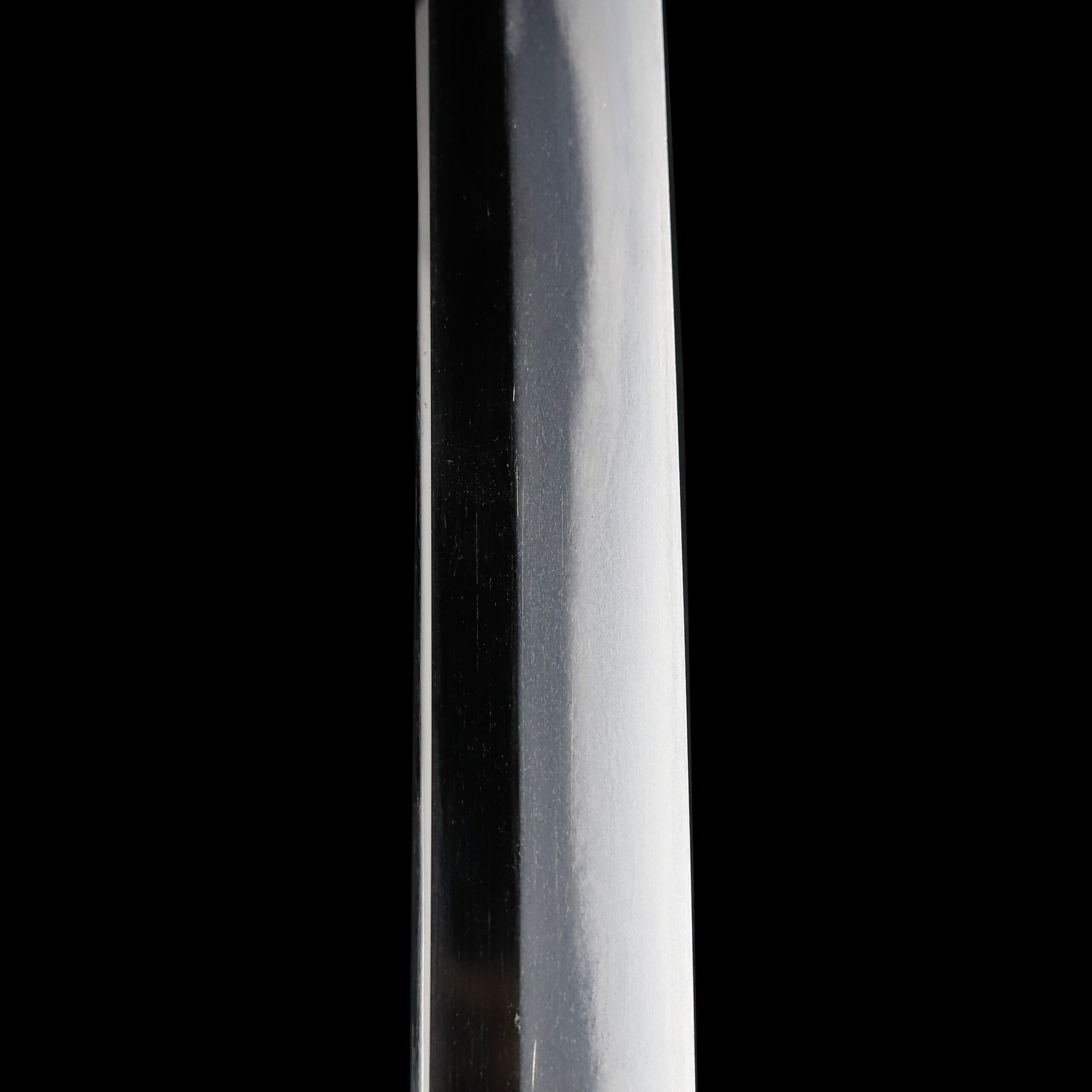
Nakago:Nakago is the tang of the Japanese sword.
Japanese swordsmiths left the black rust on the tang because it prevents red rust while the tang is in its handle. And the discoloration of the tang was created over time, and it is a great indicator for a Japanese sword specialist to estimate when the sword was forged.

Koshirae: Koshirae is the mounting of the Japanese sword. There are several parts that consist of Koshirae such as Saya(Scabbard), Tsuka(Handle), Tsuba(Handguard).
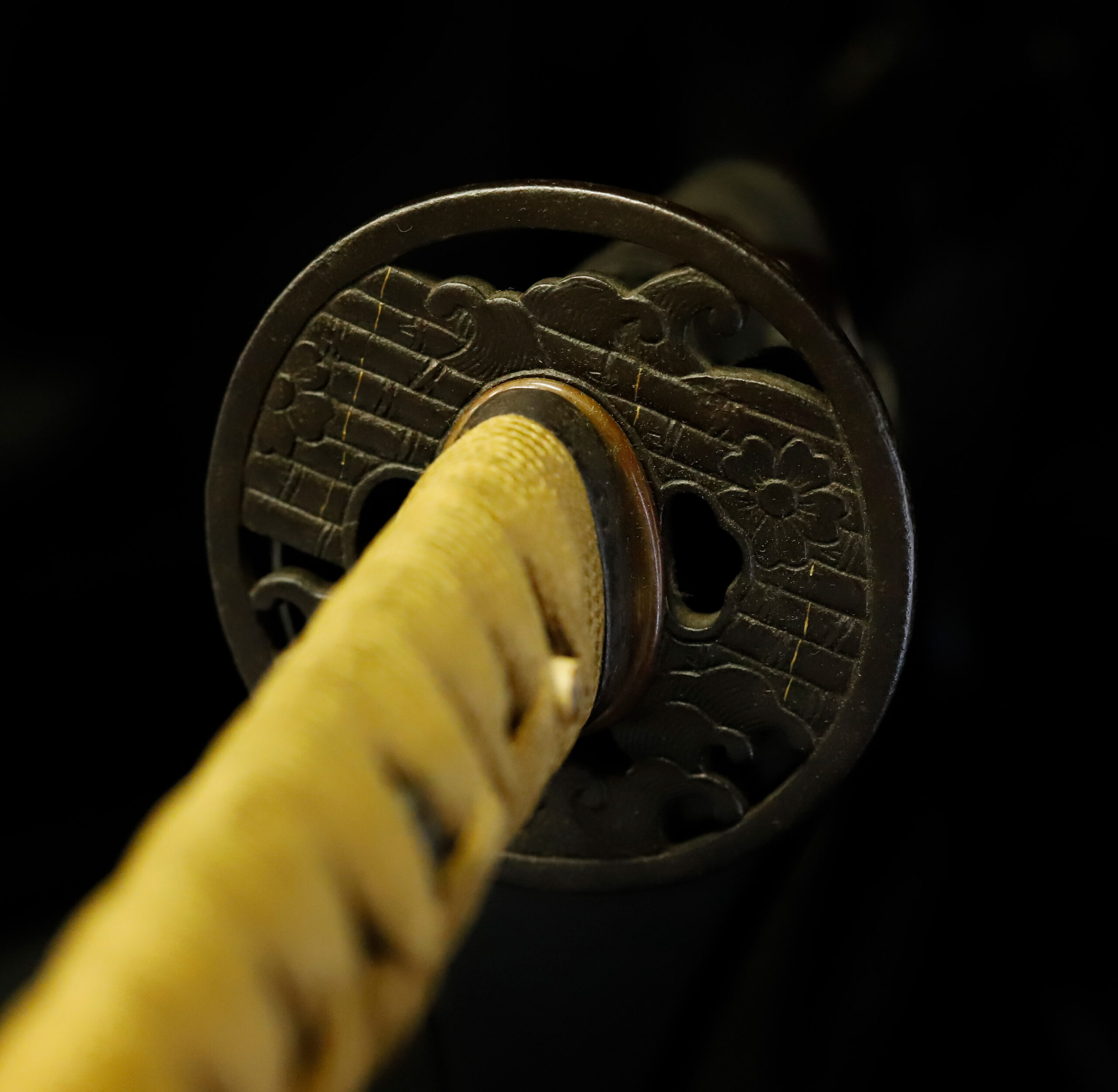
Fuchi-Kashira:A pair of matching sword fittings that cover the upper and bottom parts of its sword hilt.
The Sakura (桜, cherry blossom) pattern is designed on this Fuchi Kashira. Cherry blossom is one of the seasonal things of spring, and it has been loved for a long time in Japan. Its pattern is designed not only for sword mountings but also for Kimonos (着物, traditional Japanese costume) and furnishings. A theory says that the god of grain exists in cherry blossoms. Therefore, this flower pattern has been treated as the symbol of a plentiful harvest. People held a traditional custom under cherry blossom trees to pray for a bumper year in ancient times.
It is said this is the origin of the cherry blossom viewing picnic today. Until the Kamakura period, people in politics, or rather those in the upper class, enjoyed cherry blossom viewing. This event has spread to the ordinary people in the Edo period. It is said that cherry blossoms were planted as a disaster prevention measure. According to a theory, it was impossible to build embankments along all the rivers, which would flood during heavy rains. Therefore, it is said that by planting cherry blossoms as an alternative to the embankment, ordinary people had more opportunities to enjoy cherry blossom viewing. In any way, we would say that this flower is familiar to Japanese people.
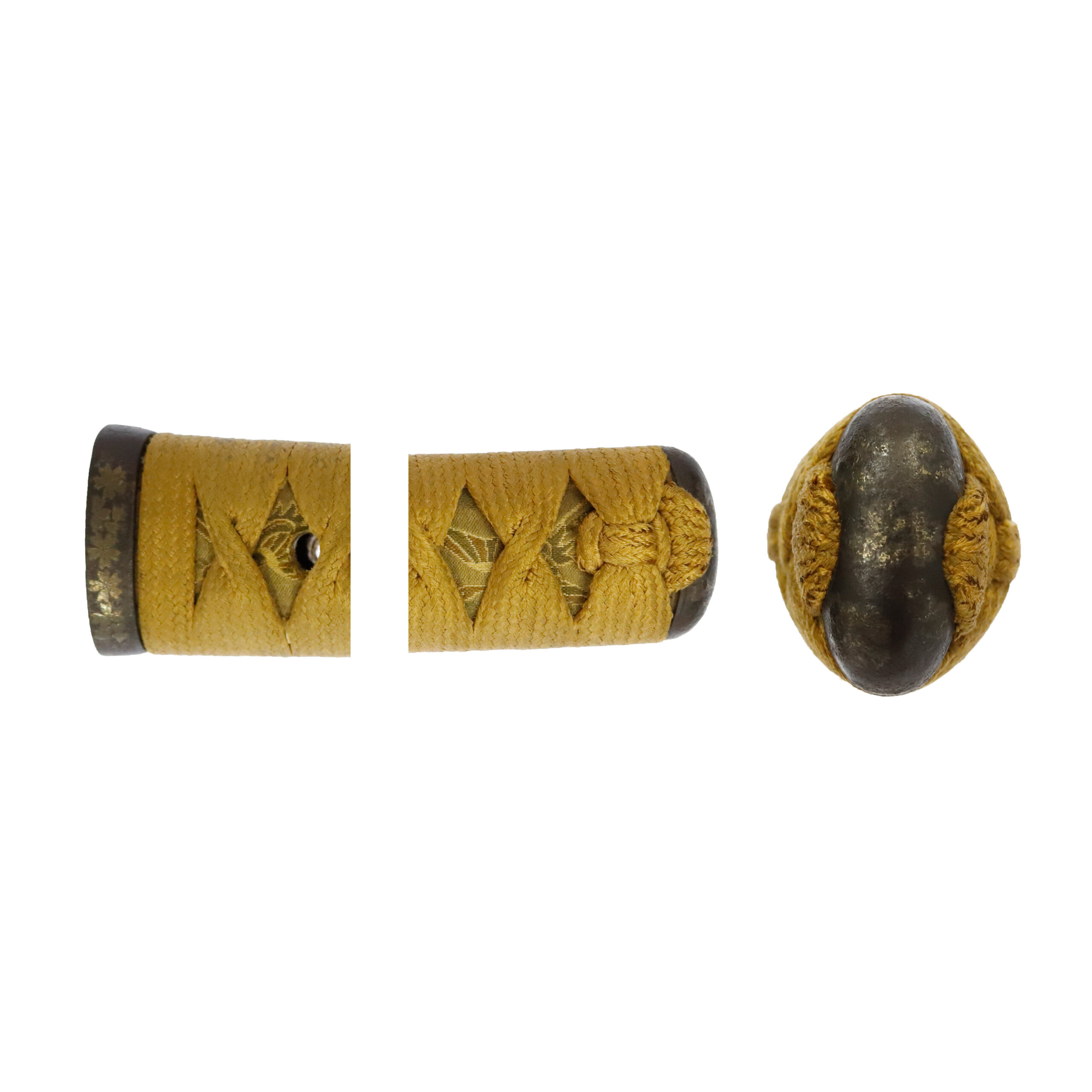
Tsuka and Menuki:Tsuka is the handle of the Japanese sword and Menuki is its decoration.
Seeing from the gaps of the Tsukamaki thread, we could see a kind of animal figures. We estimate Ushis (牛, cow) are the motifs of this Menuki. Cows have been familiar with human life since ancient times. They are indispensable in multiple situations: food, labor force for farming, or carrying goods. People have thought this hard-working animal’s figure symbolizes integrity. According to a theory, that is why the cow was added to the twelve signs of the Japanese zodiac.
In addition, the Japanese name of cow, “牛,” is also written as “丑.” There is the letter “紐,” which means string in Japanese. Now you would notice that “丑” is used in the “紐” letter. Therefore, there is an idea that considers “丑” has a meaning such as connect (tie) or take (grasp). Based on these ideas, Samurai might have associated this animal design with the meaning such as “form a connection” or “grab the victory” and incorporated this design for sword mountings, as you see in this Menuki.
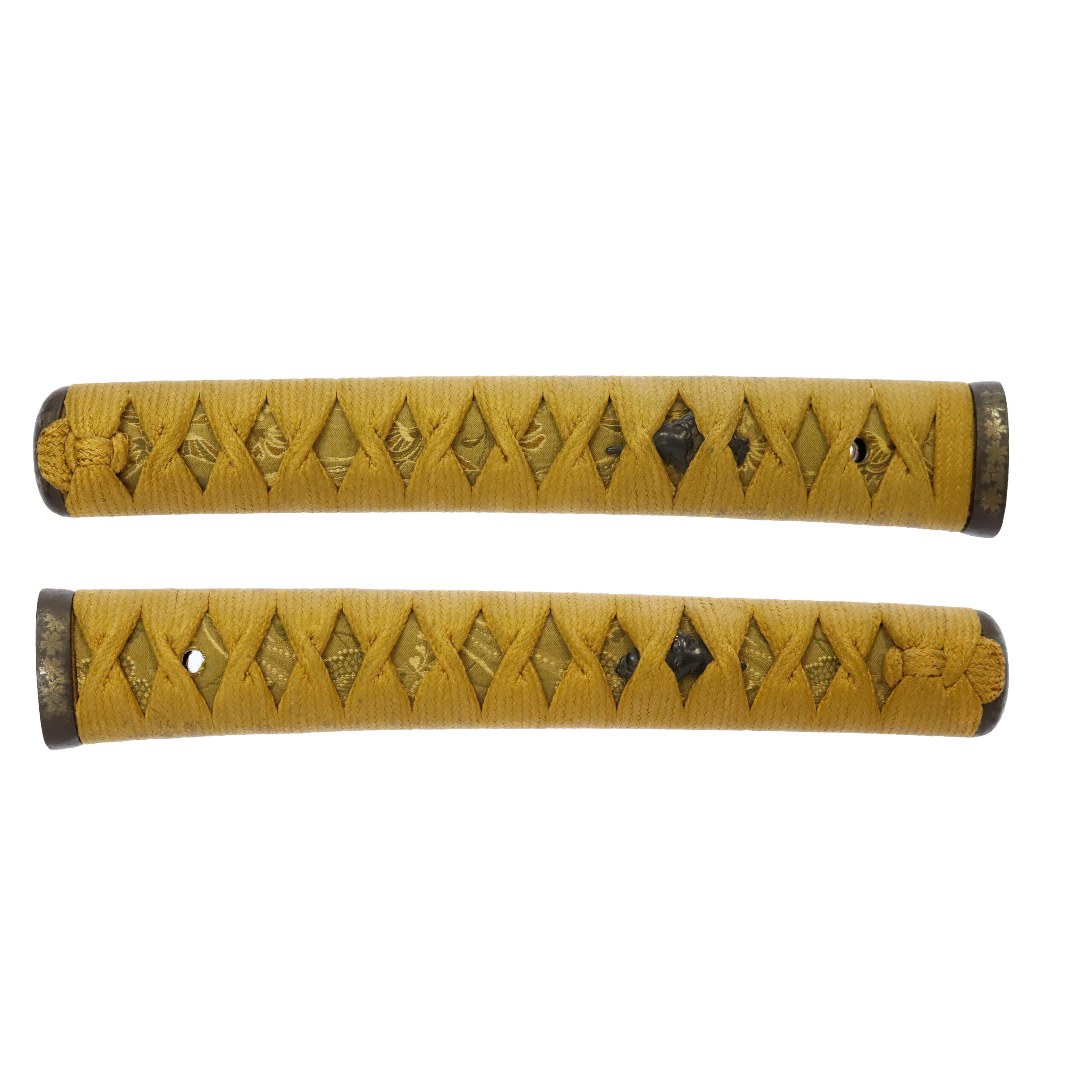
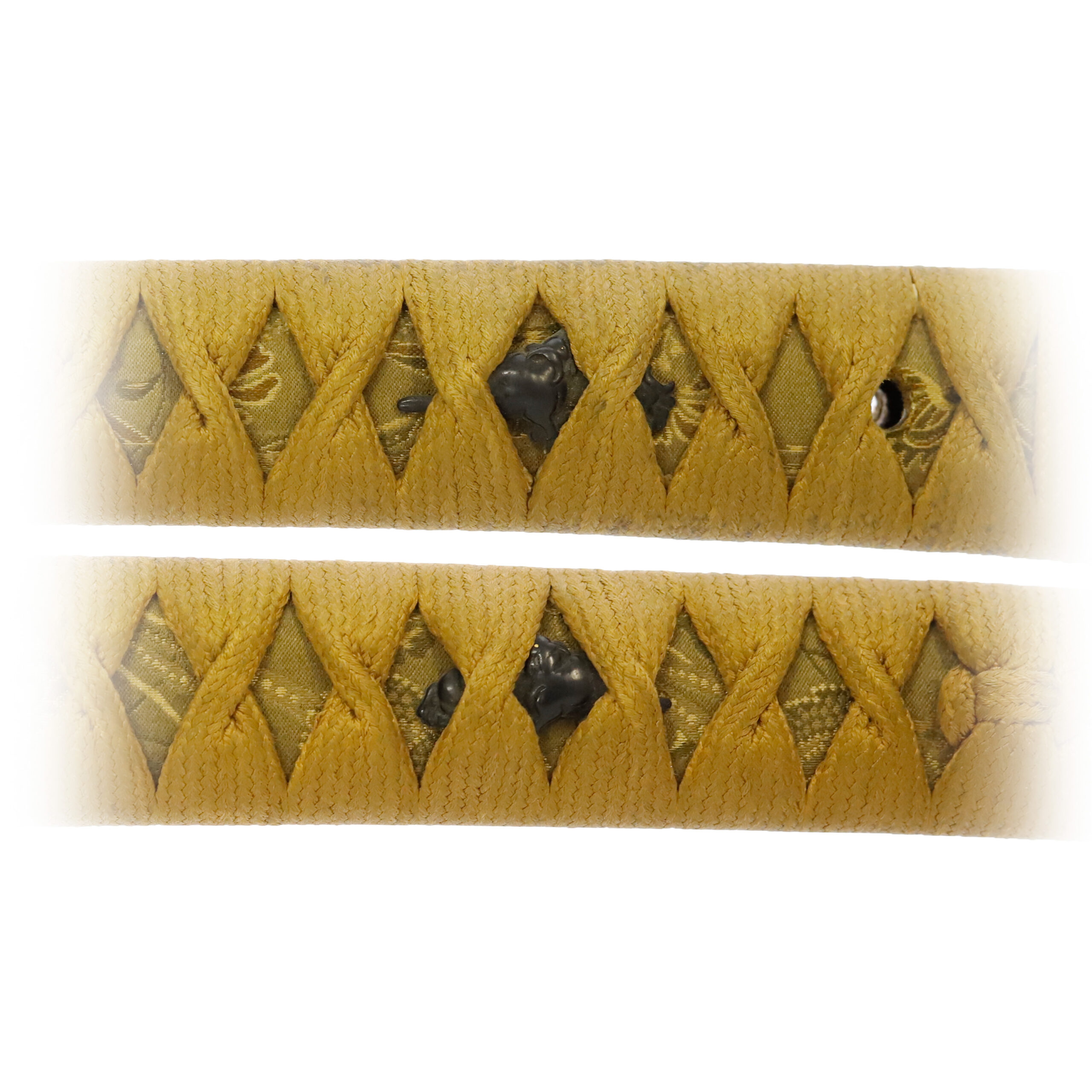
Tsuba and Habaki:Tsuba is the handguard for the Japanese Sword and Habaki is the equipment to make the blade not touch its scabbard inside. It prevents the blade from getting rusty and chipped.
The same as the Fuchi Kashira, this Tsuba’s design is related to cherry blossom. We could see cherry blossoms, waves, and a raft on this screen. This design is called the Hanaikada (花筏, flower raft) pattern. Initially, it refers to the way flowers fall and fall into the river. However, this pattern depicts a raft made of wood when it is treated as a design. Also, the pattern of cherry blossoms floating in running water is also called the Sakuragawa (桜川) and represents “the beginning of things never ending = a continuation of happy things.” This Tsuba might be designed based on such an auspicious idea.
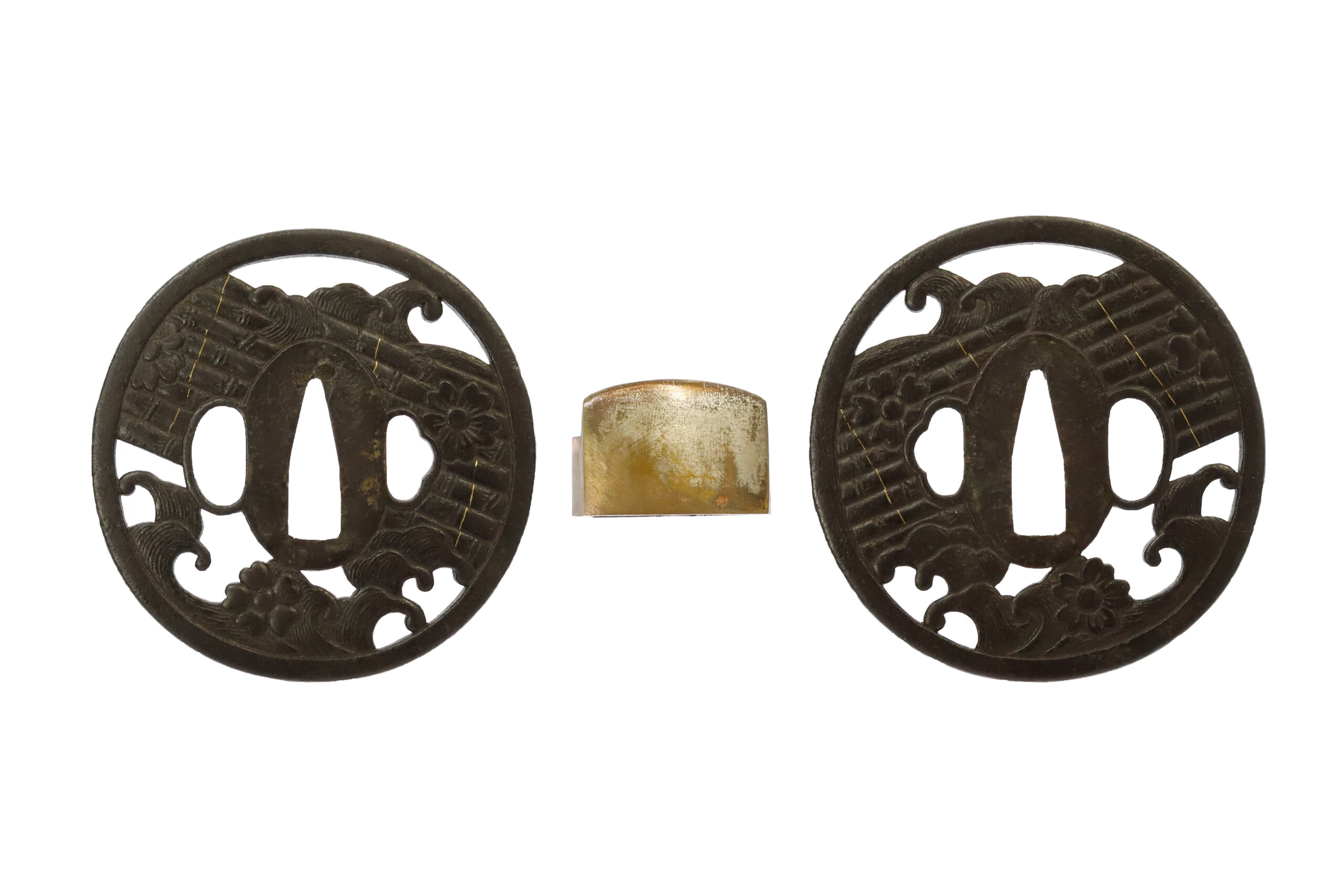
Saya: Saya is the scabbard for the Japanese sword.
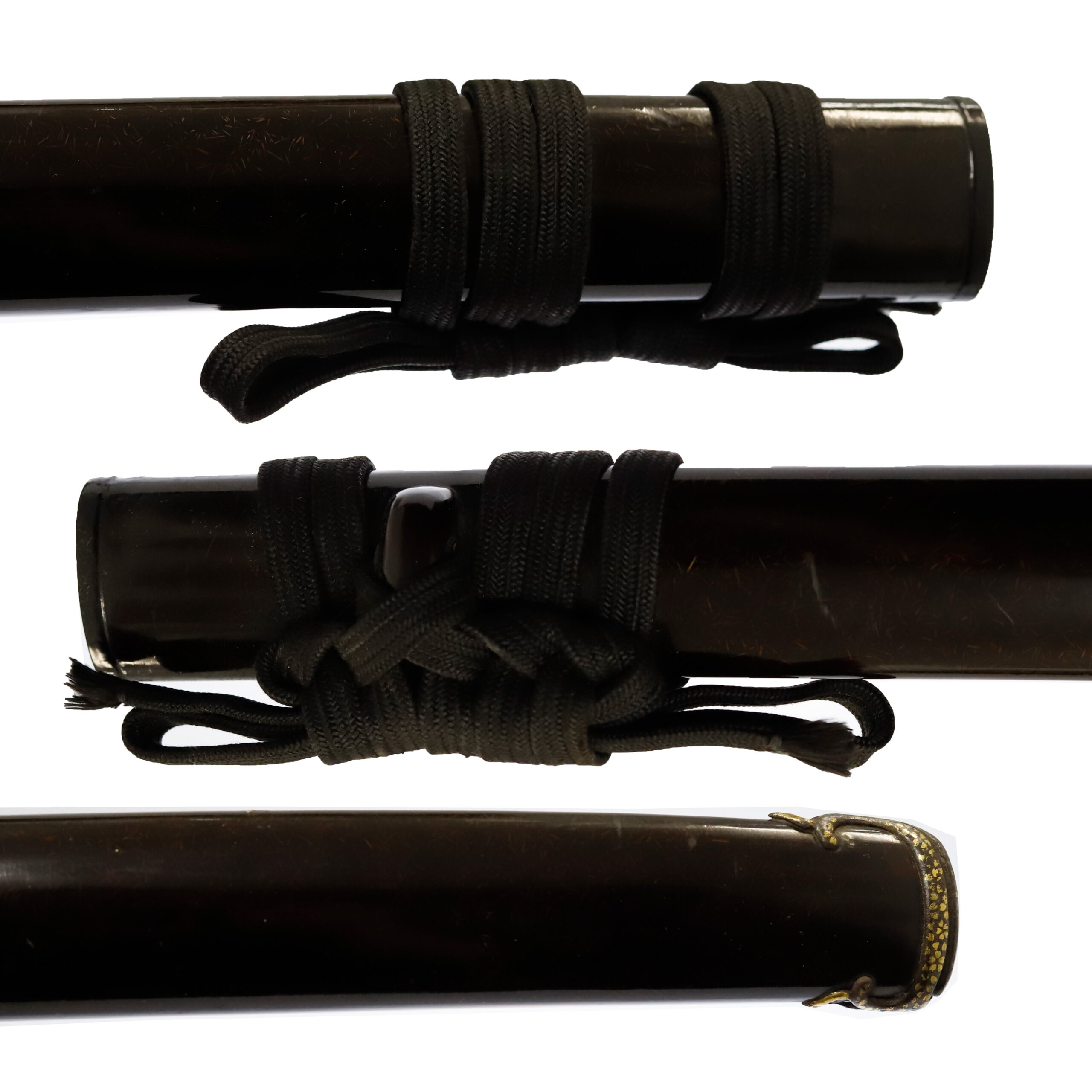
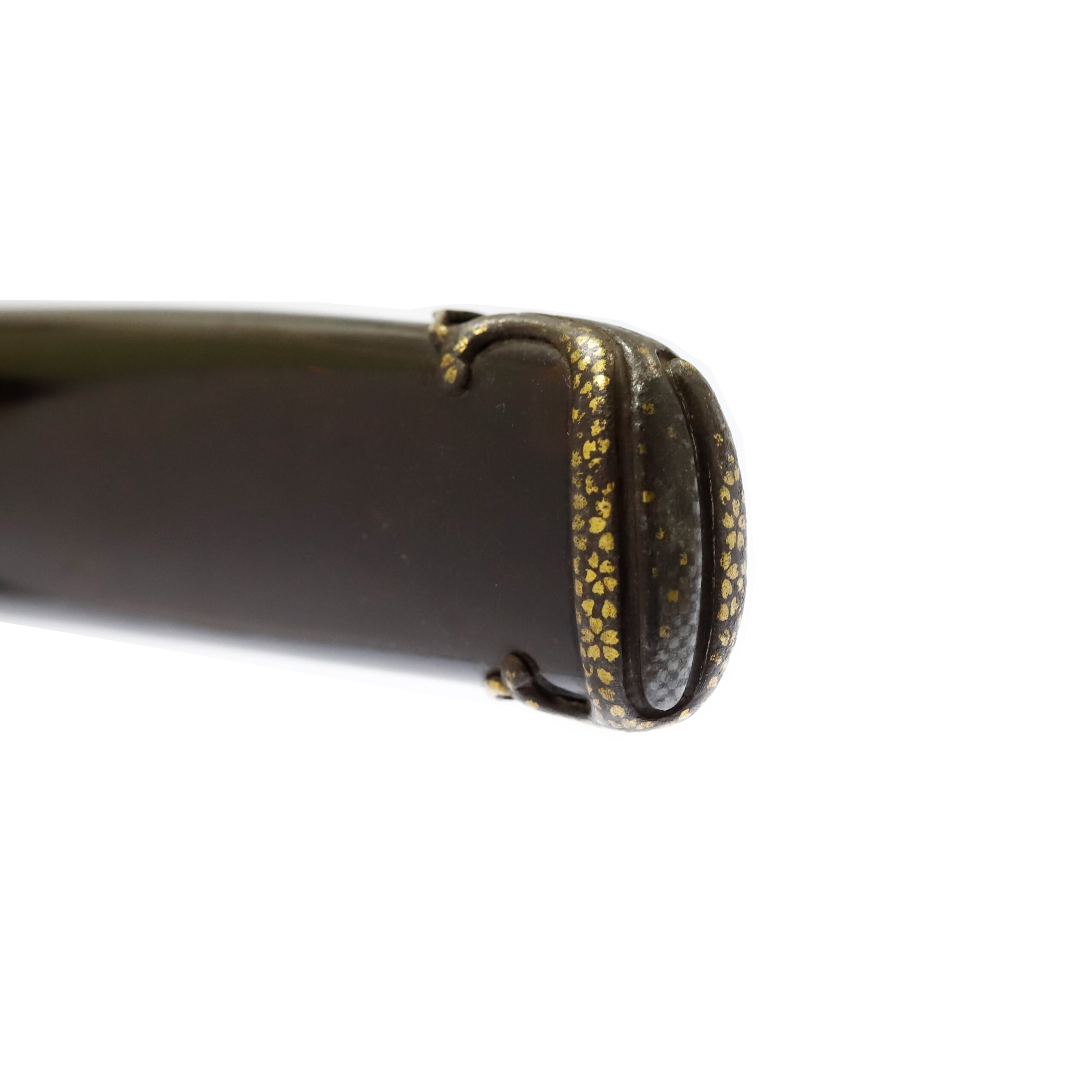
Authentication Paper:NBTHK TOKUBETSU Hozon Certificate for the blade (No. 1019657)
NBTHK, also known as Nihon Bijutsu Touken Hozon Kyokai (the Society for the Preservation of the Japan Art Sword), is one of the oldest Japanese sword appraising organizations in modern-day Japan. They authenticated the blade on March 10th in the 5th year of Reiwa (2023). They appraised it as Tokubetsu Hozon Touken, the blade especially worth preserving for Japanese society. The purchaser will receive this original certificate as well. We can also translate what is written into English and make a PDF file for your record if you request.

Registration Number : Okayama 102783
The Board of Education in Okayama prefecture issued a registration paper for this sword . It is called Jyu Token Rui Torokusho(銃刀剣類登録証). Bunkacho(The Agency for Cultural Affairs) acknowledges a Japanese sword with this paper as a work of art.
The sword needs to be traditionally hand-forged and made of Tamahagane carbon steel to be registered in the system. With this paper, its owner in Japan can legally own an authentic Japanese sword. Based on this registration number, we will apply for its export permit.
This paper will need to be returned to the board of education when the sword is being shipped abroad, but you can receive a copy of it. An English translation of this registration paper is available on request.

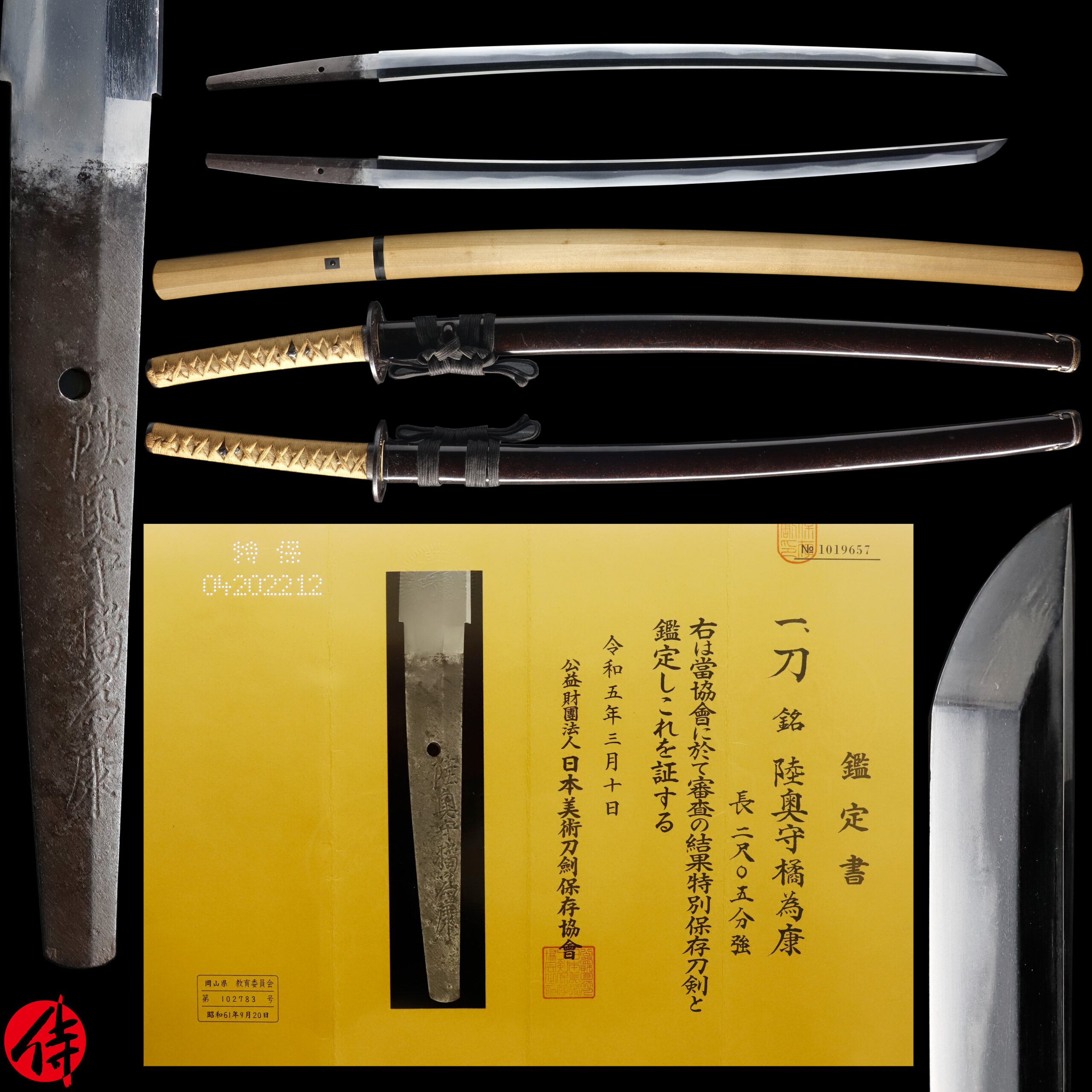
—————————————————————–
【About us】
Samurai Museum is located in Tokyo, Japan, exhibiting antique artifacts related to the Samurai history. Samurai Museum Shop is the place for those who are interested in Japanese culture and craftsmanship. We deal with antique Samurai swords/armor, traditional crafts made in Japan and so on.
【Japanese Sword& Export Process】
The Japanese swords we deal with are hand-forged edged swords made in Japan. It was made from the traditional carbon steel called TAMAHAGANE(玉鋼). Samurai Museum is familiar with the proper legal procedure for an antique/ authentic Japanese sword to be exported from Japan. We have sent more than 700 Japanese swords for the past few years (~2024) to amazing owners who appreciate its historical value.
Each Japanese sword is registered under the Agency for Cultural Affairs and the Board of Education in Japan. They issue a registration paper for each Japanese sword for its owner in Japan to legally possess it. The Japanese sword with its registration paper means it was traditionally hand-forged in Japan.
To legally export the sword from Japan to other countries, we will have to apply for its permit to the Agency for Cultural Affairs(Bunkacho) and return the original registration paper to the Board of Education. It normally takes around 2-4 weeks to receive this permit after submitting required documents. And we would like you to expect at least 1-1.5 months for your order to arrive at your given address after you ordered. For more detailed info, please click here.
It is allowed for residents in Japan to own authentic Japanese swords without a special license as long as they come with registration papers. Please feel free to contact us if you are a resident of Japan, whether temporarily or permanently. We will also assist you when you leave Japan and need to obtain the export permit.
【Payment Method】
We accept payment through Stripe (Credit card), PayPal, Apple Pay or ChromePay, all of which are secure payment methods. Also, you don’t need to make an account on Stripe for the checkout. If you prefer other payment method, please contact us. After confirming your payment, we will apply for an export permit. You may either pay in JPY, USD, AUD, CAD,EUR CHF or GBP. The price is set in Japanese Yen. Prices in other currencies are automatically calculated based on the latest exchange rate.

* If the amount is above 1 million JPY, Stripe or wire transfer will be the only options for payment.
【Shipping】
We have shipped authentic Japanese swords to the USA, UK, Canada, Mexico, Germany, France, Hong Kong and Australia. If you don’t live in these countries and like to order, please contact us first before making a purchase. We offer Free International Shipping as long as we can send antique Japanese swords by EMS.
We normally ship by EMS(Express Mail Service) provided by Japan Post. We will send you a tracking number for your order as soon as we hand it to the post office. We will put 100 % insurance on the shipping document without any extra charge. Based on the total amount, there might be a duty tax or other fee for you to pay, depending on the countries. We use package cushioning to protect the item and put it in a PVC pipe, which is one of the most secure packages because of its durability.
It will normally takes 5-14 days for the item to arrive at your given address after we dispatch it. Time of delivery is estimated as accurately as possible by the carrier but does not take into account any delays beyond our control such as by inclement weather, post office holiday seasons.
* If you live in Australia and like to purchase an authentic Japanese sword, please click here to know the detail.

【Review】
Here is one of the reviews we received from a customer who purchased an authentic Japanese sword from us. For more reviews, please click here.
“My experience overall with the whole process was wonderful. I had many questions about the history and process to purchase these treasures. All my questions were answered very timely and complete. The staff is very knowledgeable and very well versed if any questions do arise.”
【How to make sure the condition】
Please keep in mind that what you are going to purchase is an antique item. We uploaded high resolution photos for you to check its condition thoroughly. If you like to see more photos with different angles, please feel free to contact us. We will be happy to send them to you so that you can make informed decision. It is essential for us to know that you are happy with your choice of a sword. and we are prepared to use the best of our ability to serve you.
【How To Contact Us】
Please contact us through email, Facebook Messenger or Live Chat if you have any questions. You can find each icon on the right side of the website. Please click one of them to reach us. We will reply to you within 1-2 business days.
【The Art of Nihonto (Japanese Sword)】
Samurai’s history is a profound, eloquent legacy of ancient Japanese warriors in which millions of people worldwide are being fascinated. If you like to find out the art of Nihonto, please click here.
【A Guide to Japanese Sword Maintenance】
After acquiring an genuine Japanese sword, it is also important to know how to take good care of it. Here is the special video for you. Mr. Paul Martin, Japanese sword expert, shows you how to give proper maintenance to your sword. By mastering how to clean the Japanese sword, its aesthetic beauty will last forever.
When you purchase a Japanese sword from us, you can get a Free Japanese sword maintenance kit. It comes with four tools(Choji Oil, Uchiko Whetstone Powder, Peg remover, Oil Applicator). By watching the video instruction above , you can enjoy learning how to maintain your Japanese sword while appreciating it. If you have any difficulty assembling the sword or cleaning the blade, you can feel free to contact us.


MORE ANTIQUE JAPANESE SWORD FOR SALE
SWORDS WITHOUT CERTIFICATES FOR SALE
LEARN JAPANESE SWORD TERMINOLOGY
Thank you for reading all the information on the page. If you have any difficulty choosing the right Japanese sword for you, we will be more than happy to help you find the one that speaks to you the most. Please feel free to contact us.
